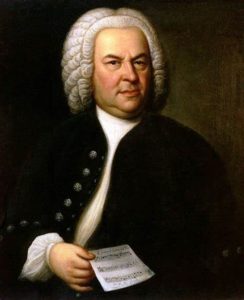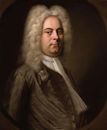April 13, 2023, Davies Symphony Hall: The San Francisco Symphony and Chorus celebrated the best of the Baroque with their precise and gorgeous performance of Johann Sebastian Bach’s Magnificat in D major, BWV, 243 (1723). Guest conductor Dame Jane Glover, a leader of the world of early music, conducted. It was an all star event. Vocal soloists were Cheryl Cain, soprano; Morgan Balfour, soprano; Leandra Ramm, mezzo soprano; Michael Jankosky, tenor; Matthew Peterson, baritone.
 Johann Sebastian Bach, composer (1685-1750)
Johann Sebastian Bach, composer (1685-1750)
Bach wrote The Magnificat soon after moving to Leipzig. It was his home for the rest of his life. His Magnificat was performed on Christmas day. His first version of it was a bit higher, E-flat major, than the one performed now in D major. In the first version, he included Christmas texts which are now called Christmas interpolations. He premiered the new version in the summer of 1733. All of the text of the music comes from Luke 1:46-55. Mary has experienced the Annunciation, learns that Elizabeth, her older relative, will also have a baby, and together they sing their joy about their unusual but blessed situations. The work opens with the statement, “Magnificat anima mea Dominum” ( My soul magnifies the Lord). Each of the 12 movements has its own kernel of an idea. The meaning and singing of the messages are compressed so that the Magnificat contains all of the religious story in the most direct way. It is a demonstration of the power of concise construction. The music and singing are directed to the audience in a way that lifts their hearts in joy as well.
 Dame Jane Glover, conductor
Dame Jane Glover, conductor
Bach’s Concerto for Oboe and Violin in D minor, BWV 1060 was originally composed for harpsichord. Apparently, Bach would write for harpsichord but then transcribe the music for other instruments. The composition of this work started probably in 1730-1733. The harpsichord has characteristics all its own. The sounds it makes do not last, it has a greater range than other instruments, and it can play multiple notes at a time. The late, great music writer Michael Steinberg observed that the differences of the instruments Bach wrote for meant that he would change the key so that the music would suit each instrument’s character. This glorious piece for oboe, violin, and orchestra was reconstructed by Max Schneider in 1920, two hundred years after the original, two-harpsichord concerto in C-minor which is now lost. Whatever the mysterious origins of the Concerto we hear now, it is completely beautiful. The soloists made the music fly. Eugene Izotov, Principal Oboe of the SFS, and Alexander Barantschik, Concertmaster of the SFS were extraordinary. Watching the physical act of Concertmaster Barantschik playing the violin was visually fascinating at the same time as the completely wonderful music. Principal Oboist Izotov’s oboe demonstrated the remarkable expressive gifts of the oboe. This music in three movements has beauties that are full of energy, graceful, touching, and embracing. The Allegro ending movement captures the audience in its musical arms. We want to go there again.
The program after intermission belonged to Handel even though it opened with a lovely, new piece. Stacy Garrrop’s Spectacle of Light, was a complete delight. This was its SFS premiere. Ms Garrop was present to speak to the audience about the visual imagery that inspired her music. While that was very interesting, one hears the excitement of a gathering waiting for fireworks to begin, the pop and bigger explosions of light and color, and even the fizzle of the last sounds of the display. While Ms Garrop’s piece matched the event depicted in an etching she had seen and which was included in the program, the Spectacle of Light can stand on its own as bright and colorful music piquing the listener’s imagination.
 George Frideric Handel (1685-1759) composer
George Frideric Handel (1685-1759) composer
The Music for the Royal Fireworks was commissioned to celebrate a peace treaty, the Treaty of Aix-la-Chapelle. It is impossible to describe why there was a War of the Austrian Succession, so on to the music. Handel was given instructions and sometimes demands about what music he should create. The aristocratic bureaucrats and courtiers competed with each other with their ideas. The stage designer Giovanni Niccolo Servandoni out Disney-ed Disney in an era without electricity. There were to be gigantic images of Greek gods and of King George II, triumphal arches, and The Biggest Fireworks. Handel first required 16 trumpets and horns. Then, he cut back to only 12 of each. Unlike most modern producers, reducing the numbers upset the quarrelsome Duke of Montagu and the Comptroller of his Majesty’s Fireworks as well as for War as for Triumph. As for the King, he mostly wanted “no fidles.” Handel’s plan was to follow the 18th century French style influenced by Jean-Phillippe Rameau. It is a calm and rather official sounding opening followed quickly by faster music. Again in the French style, Handel composed a dance movement, the Bourree. Another kind of dance, this one slightly Italian with a siciliano character follows with a title, La Paix/Peace. Appropriately following La Paix is La Rejouissance/Rejoicing. This last section sounds almost almost like a march. Handel has an interesting way with these movements. His instructions are that La Rejouissance is played three times, each with different instruments leading the way: first it is trumpets, woodwinds and strings; then, horns and woodwinds; last with all the instruments. He ends the festival music with music of another dance style, the minuet. It is so appropriate that the Baroque dance styles play an important role in Handel’s music. Jean-Phillippe Rameau wrote music for ballets, and he followed in the ballet steps of Lully, the founder of French ballet music. The Music for the Royal Fireworks is a journey through glory; even and orderly art; fantastic festivities. The SFS, led by Dame Jane Glover, produced all the sound, images, and thrills in a way that Handel and King George II would appreciate. Early in his tenure as Artistic Director of the San Francisco Ballet, Helgi Tommason created a wonderful ballet for this music. The danseurs tossed their ballerina partners into the air like colorful fireworks or stars.